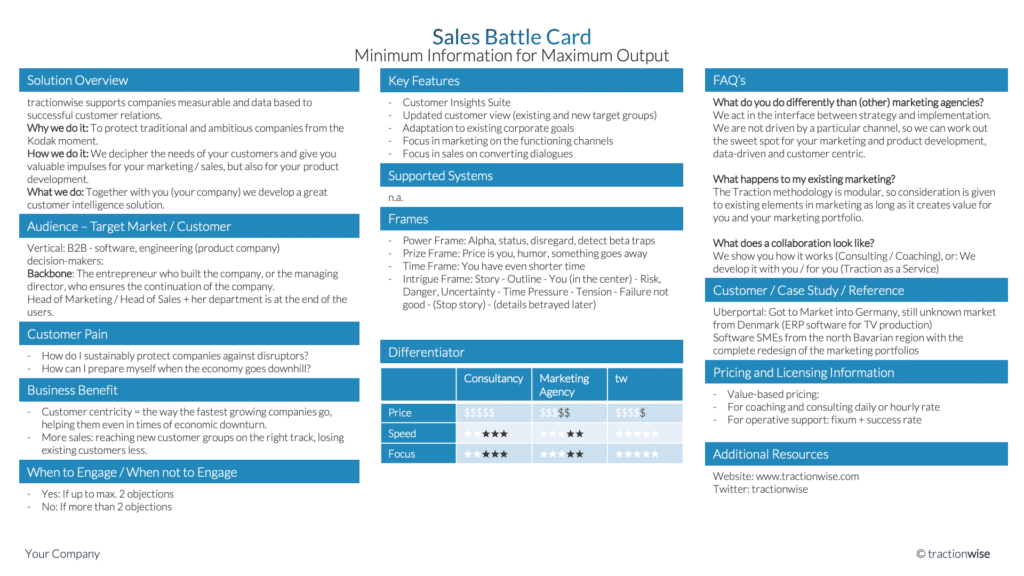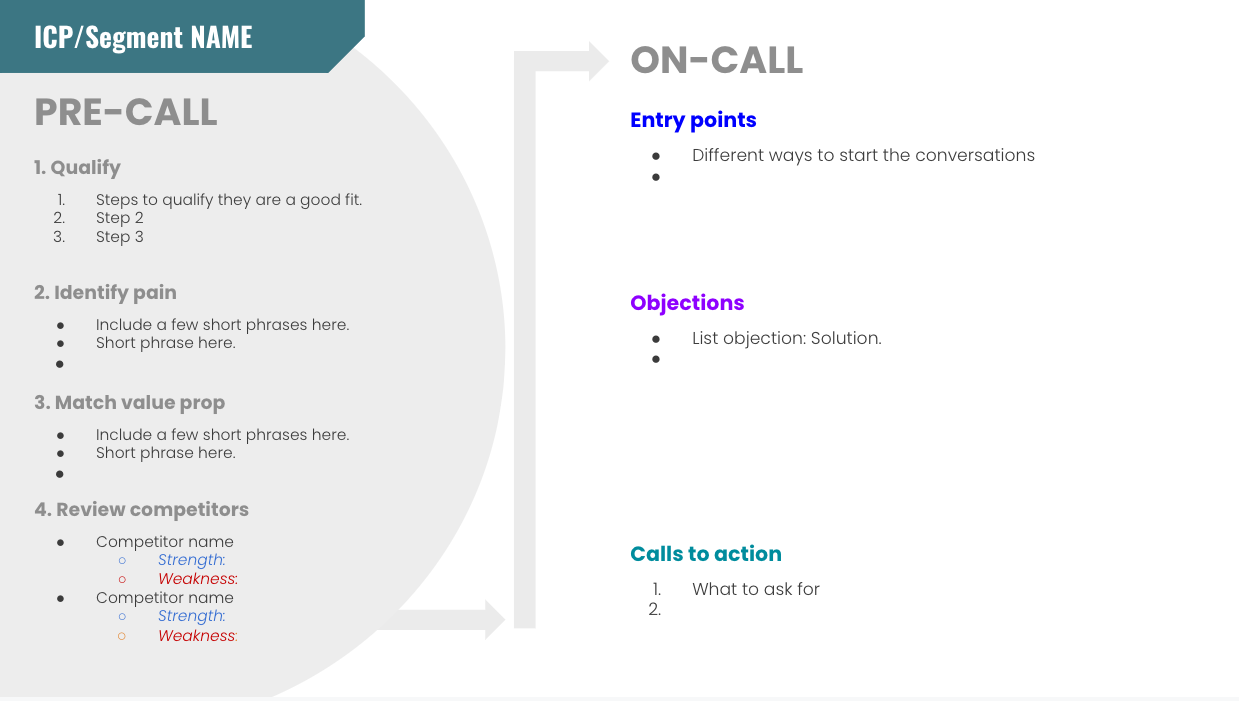
You spent lots of time developing detailed battlecards for your reps, but no one seems to use them. Frustrated?
Chances are the cell-based cheat sheet with bullet points and crammed text aren’t exactly useful or nimble for a modern sales rep, both from a format and usability standpoint.
Sales consultant at the Maestro Group, Will Fuentes, sees this over and over again at companies. “Battlecards make orgs feel good but their promise and execution of them is wildly different. I rarely see orgs execute on it in a way that is worthwhile.”
Bad battlecard examples
Take a look at these battlecard templates we found from around the internet that look informational but fall short of being practical. They look more like student cheat sheets on note cards for a test, which is fine if you have lots of time, but that’s something reps don’t have. In fact, reps are currently under pressure to personalize/customize their outreach at scale.


A sales rep's workflow
There is no chance a rep is going to reference either of those battlecards in the middle of their workflow. In fact, let's take a look at what a modern rep's workflow typically entails so you can understand why your battlecards need to be simplified.
Qualify prospect > match the prospect to a segment > check CRM for past activity > research prospect online > match the segment to a battlecard > sort through battlecard to craft message or make phone call > attempt to convert prospect.

If you emphasize volume but want reps to also personalize, you need to boil down your overwhelming battlecards and make them quicker and easier to navigate.
Sales consultant, Scott Leese, suggests “Turning your battlecards into a hero's journey that is visual. Think of your battlecards as a sales adventure.” We took Scott's suggestion for our template and formatted it as a linear path with casual styling.
Battlecard format / styling:
- Match your battlecard to your rep’s workflow. Make it a linear, natural progression.
- Do they start by qualifying a prospect?
- Do they research the prospect on your CRM or on the web?
- Utilize color and bolding to guide reps’ eyes.
- Include padding and whitespace.

download the slides here
Great, but what about the content? If we look at template battlecards there is a slew of content that can be distilled as well. Your reps don’t need EVERYTHING under the sun. They need the right thing at the right time. If you frame a battlecard as a guide to success you’ll want to give reps key advice as well as key messaging.
Key advice to include:
- Include tribal knowledge you know about your ICPs. What makes them tick?
- What has been proven to convert more conversations in the past?
- What is the workflow/script your A+ reps use?
Key messaging / content to include:
- Keywords / phrases you know move the needle for a specific ICP.
- Subject lines and CTA’s you know get replies.
- Links to relevant case studies and videos.
Objection handling:
- Don’t need full sentences here. Use keywords for objections a rep can quickly scan for while they are on a call.
- You can’t cover every possible scenario in the space of a battlecard, so just include the most common objections.

download the slides here
The end result should be something a sales rep can reference quickly and actually find value in. If it adds friction and doesn’t provide value, we lost.
What we created is probably missing a lot of things you have seen in battlecards in the past. Take this with a grain of salt and feel free to adapt this to your reps’ specific workflows. In this instance we are assuming our reps are making calls and split the battlecard into “pre-call” and “on-call” sections. This helps focus a rep’s attention and lets them quickly scan and speaks to Scott Leese's recommendation of making a visual journey.
Training reps effectively with battlecards
Don’t just send your reps your battlecards and test them on them. This is analogous to having students memorize info but not actually comprehend it. You want smart reps, not robots reading instructions.
Legendary sales consultant, Richard Harris, suggests role playing. “It’s about getting them coaching on their pace, tone, inflection, and presentation skills.”
This needs to be done with mock calls, not done alone staring at a battlecard. Dedicate resources and time to role playing over anything else.
Dynamic battlecards
One issue with battlecards is that they often get used by a rep for a short period of time then start collecting dust. This is a HUGE missed opportunity for sales leaders. Your ICP behaviors change all of the time as well as market trends and conditions. This means your sales tactics and messaging need to adapt as well.
The issue has always been that updating battlecards is time consuming and tedious. It’s also a challenge to get experienced reps to refer back to battlecards.
According to sales consultant at Altus Alliance, Tony Lanham, this is the next generation of battlecards. “I’ve never seen dynamic battlecards… historically they have always been static.”
download the slides here

